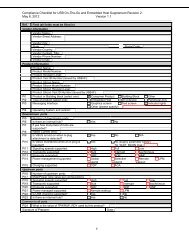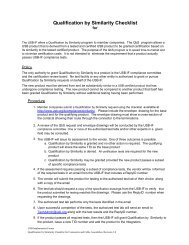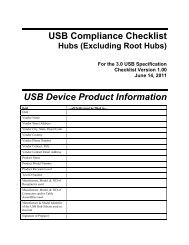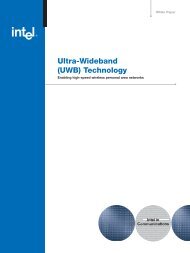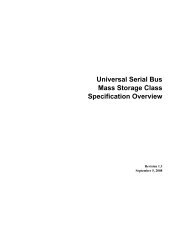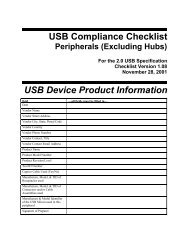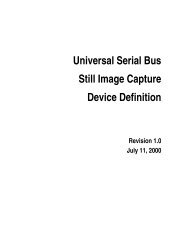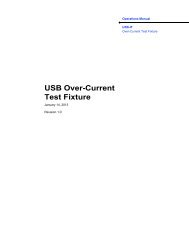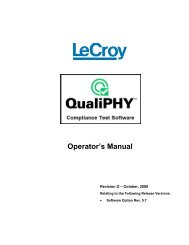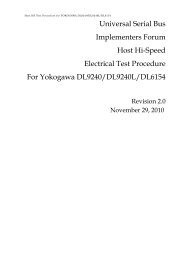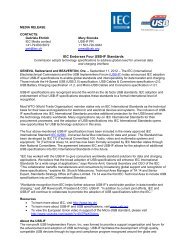Host Hi-Speed Electrical Test Procedure for Agilent - USB.org
Host Hi-Speed Electrical Test Procedure for Agilent - USB.org
Host Hi-Speed Electrical Test Procedure for Agilent - USB.org
Create successful ePaper yourself
Turn your PDF publications into a flip-book with our unique Google optimized e-Paper software.
<strong>Host</strong> <strong>Hi</strong>-<strong>Speed</strong> <strong>Electrical</strong> <strong>Test</strong> <strong>Procedure</strong> <strong>for</strong> <strong>Agilent</strong> Infiniium Revision 1.2<br />
Universal Serial Bus<br />
Implementers Forum<br />
<strong>Host</strong> <strong>Hi</strong>-<strong>Speed</strong><br />
<strong>Electrical</strong> <strong>Test</strong> <strong>Procedure</strong><br />
For <strong>Agilent</strong> Infiniium<br />
Revision 1.2<br />
August 6, 2003<br />
1
<strong>Host</strong> <strong>Hi</strong>-<strong>Speed</strong> <strong>Electrical</strong> <strong>Test</strong> <strong>Procedure</strong> <strong>for</strong> <strong>Agilent</strong> Infiniium Revision 1.2<br />
Revision <strong>Hi</strong>story<br />
Rev Date Filename Comments<br />
0.9 (Beta) Nov-23-2001 <strong>Host</strong> HS <strong>Test</strong> <strong>for</strong> <strong>Agilent</strong>.DOC Primary version of <strong>Hi</strong>-<strong>Speed</strong> <strong>Test</strong> <strong>Procedure</strong> adapted to<br />
<strong>Agilent</strong> test equipment based on the test procedure created<br />
by <strong>USB</strong>-IF (version 0.9)<br />
1.0 Feb-5-2002 <strong>Host</strong> HS <strong>Test</strong> <strong>for</strong> <strong>Agilent</strong>.DOC Edit <strong>for</strong> final release.<br />
1.2 Aug-6-2003 <strong>Host</strong> HS <strong>Test</strong> <strong>for</strong> <strong>Agilent</strong>.DOC Edit to adapt test procedure <strong>for</strong> use with 5485x series<br />
Infiniium oscilloscope and 113xA InfiniiMax differential<br />
probes.<br />
Please send comments via electronic mail to techsup@usb.<strong>org</strong><br />
<strong>USB</strong>-IF <strong>Hi</strong>gh-speed <strong>Electrical</strong> <strong>Test</strong> <strong>Procedure</strong><br />
ª Copyright 2001, <strong>USB</strong> Implementers Forum, Inc.<br />
All rights reserved.<br />
2
<strong>Host</strong> <strong>Hi</strong>-<strong>Speed</strong> <strong>Electrical</strong> <strong>Test</strong> <strong>Procedure</strong> <strong>for</strong> <strong>Agilent</strong> Infiniium Revision 1.2<br />
DISCLAIMER OF WARRANTIES<br />
THIS SPECIFICATION IS PROVIDED “AS IS” AND WITH NO WARRANTIES OF ANY KIND,<br />
EXPRESS OR IMPLIED, INCLUDING, WITHOUT LIMITATION, NO WARRANTY OF<br />
NONINFRINGEMENT, NO WARRANTY OF MERCHANTABILITY, NO WARRANTY OF FITNESS<br />
FOR A PARTICULAR PURPOSE, NO WARRANTY OF TITLE, AND NO WARRANTY ARISING OUT<br />
OF ANY PROPOSAL, SPECIFICATION, OR SAMPLE, ALL OF WHICH WARRANTIES ARE<br />
EXPRESSLY DISCLAIMED.<br />
WITHOUT LIMITING THE GENERALITY OF THE FOREGOING, <strong>USB</strong>-IF AND THE AUTHORS OF<br />
THE SPECIFICATION DO NOT WARRANT OR REPRESENT THAT USE OF THE SPECIFICATION<br />
WILL NOT INFRINGE THE INTELLECTUAL PROPERTY RIGHTS OF OTHERS. USERS OF THE<br />
SPECIFICATIONASSUME ALL RISK OF SUCHINFRINGEMENT, AND AGREE THAT THEY WILL<br />
MAKE NO CLAIM AGAINST <strong>USB</strong>-IF OR THE AUTHORS IN THE EVENT OF CLAIMS OF<br />
INFRINGEMENT.<br />
<strong>USB</strong>-IF IS NOT LIABLE FOR ANY CONSEQUENTIAL, SPECIAL OR OTHER DAMAGES ARISING<br />
OUT OF THE USE OF THE SPECIFICATION.<br />
LICENSE FOR INTERNAL USE ONLY<br />
<strong>USB</strong>-IF HEREBY GRANTS A LICENSE TO REPRODUCE AND TO DISTRIBUTE THIS SPECIFICATION<br />
FOR INTERNAL USE ONLY. NO OTHER LICENSE, EXPRESS OR IMPLIED, BY ESTOPPEL OR<br />
OTHERWISE, IS GRANTED HEREWITH, AND NO LICENSE OF INTELLECTUAL PROPERTY RIGHTS<br />
IS GRANTED HEREWITH.<br />
All product names are trademarks, registered trademarks, or servicemarks of their respective owners.<br />
3
<strong>Host</strong> <strong>Hi</strong>-<strong>Speed</strong> <strong>Electrical</strong> <strong>Test</strong> <strong>Procedure</strong> <strong>for</strong> <strong>Agilent</strong> Infiniium Revision 1.2<br />
Table of Contents<br />
1 Introduction ...........................................................................................................5<br />
2 Purpose...................................................................................................................5<br />
3 Equipment Required ..............................................................................................5<br />
3.1 Equipment Setup.....................................................................................................6<br />
3.1.1 Infiniium 5485xA Digital Storage Oscilloscope..................................................6<br />
3.2 Operating Systems, Software, Drivers, and Setup Files.............................................8<br />
3.2.1 Operating Systems............................................................................................8<br />
3.3 Special Purpose Software.........................................................................................8<br />
3.3.1 <strong>Test</strong> Equipment Setup Files...............................................................................8<br />
4 <strong>Test</strong> <strong>Procedure</strong>........................................................................................................9<br />
4.1 <strong>Test</strong> Record .............................................................................................................9<br />
4.2 Vendor and Product In<strong>for</strong>mation.............................................................................9<br />
4.3 Legacy <strong>USB</strong> Compliance <strong>Test</strong>s.................................................................................9<br />
4.4 <strong>Host</strong> <strong>Hi</strong>-speed Signal Quality (EL_2, EL_3, EL_6, EL_7).........................................10<br />
4.5 <strong>Host</strong> Controller Packet Parameters (EL_21, EL_22, EL_23, EL_25, EL_55)...............17<br />
4.6 <strong>Host</strong> Disconnect Detect (EL_36, EL_37)..................................................................25<br />
4.7 <strong>Host</strong> CHIRP Timing (EL_33, EL_34, EL_35) ...........................................................30<br />
4.8 <strong>Host</strong> Suspend/Resume timing (EL_39, EL_41).......................................................34<br />
4.9 <strong>Host</strong> <strong>Test</strong> J/K, SE0_NAK (EL_8, EL_9)..................................................................38<br />
A.4 <strong>Host</strong> <strong>Hi</strong>-speed <strong>Electrical</strong> <strong>Test</strong> Data .......................................................................41<br />
A.4.2 Vendor and Product In<strong>for</strong>mation .......................................................................41<br />
A.4.3 Legacy <strong>USB</strong> Compliance <strong>Test</strong>s............................................................................42<br />
A.4.4 <strong>Host</strong> <strong>Hi</strong>-speed Signal Quality (EL_2, EL_3, EL_6, EL_7)......................................42<br />
A.4.5 <strong>Host</strong> Controller Packet Parameters (EL_21, EL_22, EL_23, EL_25, EL_55)............44<br />
A.4.6 <strong>Host</strong> Disconnect Detect (EL_36, EL_37) ..............................................................45<br />
A.4.7 <strong>Host</strong> CHIRP Timing (EL_33, EL_34, EL_35)........................................................46<br />
A.4.8 <strong>Host</strong> Suspend/Resume timing (EL_39, EL_41) ...................................................47<br />
A.4.9 <strong>Host</strong> <strong>Test</strong> J/K, SE0_NAK (EL_8, EL_9) ..............................................................48<br />
4
<strong>Host</strong> <strong>Hi</strong>-<strong>Speed</strong> <strong>Electrical</strong> <strong>Test</strong> <strong>Procedure</strong> <strong>for</strong> <strong>Agilent</strong> Infiniium Revision 1.2<br />
1 Introduction<br />
The <strong>USB</strong>-IF <strong>Hi</strong>-speed <strong>Electrical</strong> <strong>Test</strong> <strong>Procedure</strong>s are developed by the <strong>USB</strong> 2.0 Compliance Committee<br />
under the direction of <strong>USB</strong>-IF, Inc. There are three hi-speed electrical test procedures. The <strong>Host</strong> <strong>Hi</strong>-speed<br />
<strong>Electrical</strong> <strong>Test</strong> <strong>Procedure</strong> is <strong>for</strong> EHCI host controllers. The Hub <strong>Hi</strong>-speed <strong>Electrical</strong> <strong>Test</strong> <strong>Procedure</strong> is <strong>for</strong><br />
hi-speed capable hubs. The Device <strong>Hi</strong>-speed <strong>Electrical</strong> <strong>Test</strong> <strong>Procedure</strong> is <strong>for</strong> hi-speed capable devices.<br />
The <strong>Hi</strong>-speed <strong>Electrical</strong> Compliance <strong>Test</strong> <strong>Procedure</strong>s verify the electrical requirements of hi-speed <strong>USB</strong><br />
operation of these devices designed to the <strong>USB</strong> 2.0 specification. In addition to passing the hi-speed test<br />
requirements, hi-speed capable products must also complete and pass the applicable legacy compliance<br />
tests identified in these documents in order to be posted on the <strong>USB</strong>-IF Integrators List and use the <strong>USB</strong>-<br />
IF logo in conjunction with the said product (if the vendor has signed the <strong>USB</strong>-IF Trademark License<br />
Agreement). These legacy compliance tests are identified in the Legacy <strong>USB</strong> Compliance <strong>Test</strong> section in<br />
this document.<br />
2 Purpose<br />
This <strong>USB</strong>-IF <strong>Hi</strong>-speed <strong>Electrical</strong> <strong>Test</strong> <strong>Procedure</strong> documents a series of tests used to evaluate <strong>USB</strong><br />
peripherals and systems operating at hi-speed. These tests are also used to evaluate the hi-speed<br />
operation of <strong>USB</strong> silicon that has been incorporated in ready-to-ship products, reference designs, proofs<br />
of concept and one-of-a-kind prototypes of peripherals, add-in cards, motherboards, or systems.<br />
This test procedure makes reference to the test assertions in the <strong>USB</strong>-IF <strong>USB</strong>2.0 <strong>Electrical</strong> <strong>Test</strong><br />
Specification, Version 1.00.<br />
This <strong>Host</strong> <strong>USB</strong>-IF <strong>Hi</strong>-speed <strong>Electrical</strong> <strong>Test</strong> <strong>Procedure</strong> is one of the three <strong>USB</strong>-IF <strong>Hi</strong>-speed <strong>Electrical</strong><br />
Compliance <strong>Test</strong> <strong>Procedure</strong>s. The other two are Hub <strong>USB</strong>-IF <strong>Hi</strong>-speed <strong>Electrical</strong> <strong>Test</strong> <strong>Procedure</strong> and<br />
Device <strong>USB</strong>-IF <strong>Hi</strong>-speed <strong>Electrical</strong> <strong>Test</strong> <strong>Procedure</strong>. The adoption of the individual procedures based on<br />
the device class makes it easier to use.<br />
3 Equipment Required<br />
The commercial test equipment listed here is based on the positive experience of <strong>USB</strong>-IF members in<br />
executing the <strong>USB</strong> hi-speed electrical tests. This test procedure is written with a set of specific models that<br />
were used to develop this procedure. In time, there will be other equivalent or better test equipment<br />
suitable <strong>for</strong> use. Some minor adaptation of the procedure will be required in those cases.<br />
• Digital Storage Oscilloscope:<br />
o<br />
o<br />
o<br />
<strong>Agilent</strong> 54853A, 54854A, or 54855A Infiniium oscilloscope<br />
<strong>Agilent</strong> E2683A <strong>USB</strong> Compliance <strong>Test</strong> Option<br />
Computer monitor (optional)<br />
o <strong>Agilent</strong> 1131A, 1133A, or 1134A InfiniiMax differential probe, qty = 1<br />
o<br />
<strong>Agilent</strong> E2669A differential connectivity kit, OR E2678A socketed head, qty=1<br />
5
<strong>Host</strong> <strong>Hi</strong>-<strong>Speed</strong> <strong>Electrical</strong> <strong>Test</strong> <strong>Procedure</strong> <strong>for</strong> <strong>Agilent</strong> Infiniium Revision 1.2<br />
o<br />
o<br />
<strong>Agilent</strong> header adapter(p/n 01131-68703), qty=1, included with E2669A and E2678A<br />
purchased after October, 2003.<br />
<strong>Agilent</strong> E2697A 1Mohm adapter with passive probe ,OR 1156A, 1157A, or 1158A active<br />
probe, qty = 2<br />
• 3 ½ Digital Multimeter – <strong>Agilent</strong> 972A or equivalent<br />
o<br />
Mini-clip DMM lead – one each of black and red color<br />
• <strong>Hi</strong>-speed <strong>USB</strong> <strong>Electrical</strong> <strong>Test</strong> Fixtures<br />
o<br />
o<br />
o<br />
Device hi-speed signal quality test fixture, qty=1 (<strong>Agilent</strong> P/N E2645-66501)<br />
<strong>Host</strong> hi-speed signal quality test fixture, qty = 1 (<strong>Agilent</strong> P/N E2645-66502)<br />
<strong>Host</strong> Disconnect test fixture, qty = 1, (<strong>Agilent</strong> P/N E2645-66506)<br />
o 5V test fixture power supply, qty = 1, (<strong>Agilent</strong> p/n 0950-2546)<br />
When using <strong>Agilent</strong> hi-speed test fixtures, the nomenclature of the test point will be different from<br />
Intel’s test fixtures. This test procedure is written with reference to <strong>Agilent</strong>’s test fixtures. Please use<br />
the following cross-reference chart when using Intel’s test fixture.<br />
Intel’s Fixtures Description of the test points <strong>Agilent</strong>’s Fixtures<br />
• Miscellaneous Cables and Devices<br />
TP2 <strong>Test</strong> Point TP2<br />
J5 Power Port J5<br />
J10 Ground TP5<br />
J11 Ground TP5<br />
o 5 m <strong>USB</strong> cable, qty = 1<br />
o 1.5m <strong>USB</strong> cable, qty = 1<br />
o Modular AC power cord, qty = 2<br />
o<br />
o<br />
<strong>Hi</strong>-<strong>Speed</strong> Hub<br />
<strong>Hi</strong>-<strong>Speed</strong> Device<br />
• <strong>Hi</strong>-speed <strong>USB</strong> <strong>Test</strong> Bed Computer<br />
The hi-speed test bed computer hosts a <strong>USB</strong> 2.0 compliance host controller <strong>for</strong> hi-speed hub or device<br />
electrical test, or serves as a test bed host <strong>for</strong> a <strong>USB</strong> 2.0 host controller under test. This OS on this<br />
computer is Windows 2000 Professional. Please refer to the <strong>Hi</strong>-speed <strong>Electrical</strong> <strong>Test</strong> Setup Instruction <strong>for</strong><br />
steps to configure this computer.<br />
3.1 Equipment Setup<br />
3.1.1 Infiniium 5485xA Digital Storage Oscilloscope<br />
1. Connect keyboard and mouse to oscilloscope.<br />
2. Connect optional compute monitor to the VGA connector on the rear nearest the right side of the<br />
instrument.<br />
6
<strong>Host</strong> <strong>Hi</strong>-<strong>Speed</strong> <strong>Electrical</strong> <strong>Test</strong> <strong>Procedure</strong> <strong>for</strong> <strong>Agilent</strong> Infiniium Revision 1.2<br />
3. Attach the <strong>Agilent</strong> 113xA differential probe to Channel 1 of the oscilloscope.<br />
a. Attach the socketed probe head to the differential probe amp.<br />
b. Attach the header adapter to the socketed probe head (Figure 1).<br />
c. Handle the socketed probe head and header adapter carefully.<br />
d. For durability, epoxy can be used to strengthen the assembly. Only apply epoxy to back (noncomponent)<br />
side of probe head<br />
Figure 1. Differential Probe Setup<br />
4. Attach the E2697A adapters or 1156A probes to Channel 2 and 3.<br />
a. When using the E2697A adapter, connect the 10073C miniature passive probes to the E2697A<br />
adapter.<br />
NOTE<br />
These probe assignments will be used through out the entire test procedure.<br />
5. Turn on the oscilloscope to allow 30 minutes of warm up time prior to use.<br />
6. Configure the second monitor, if being used, while the oscilloscope is warming up.<br />
7. If the ambient temperature has changed more than 5 degrees from the previous calibration, per<strong>for</strong>m<br />
the calibration procedure built into the Infiniium 5485xA (in the [Calibration… ] section of [Utilities]<br />
pull down menu)<br />
8. If the E2697A adapter is being used, compensate the passive probes (see probe instructions).<br />
9. Calibrate all the probes.<br />
In certain test situations, there may not be a ground connection between the DSO and the device under<br />
NOTE test. This may lead to the signal seen by the differential probe to be modulated up and down due to the<br />
mid-frequency switching power supply. Connecting the DSO ground to the DUT ground will be<br />
required to establish a common ground reference.<br />
7
<strong>Host</strong> <strong>Hi</strong>-<strong>Speed</strong> <strong>Electrical</strong> <strong>Test</strong> <strong>Procedure</strong> <strong>for</strong> <strong>Agilent</strong> Infiniium Revision 1.2<br />
3.2 Operating Systems, Software, Drivers, and Setup Files<br />
3.2.1 Operating Systems<br />
Microsoft Windows 2000 Professional is required on the <strong>Hi</strong>-speed <strong>Electrical</strong> <strong>Test</strong> Bed Computer.<br />
Microsoft Windows 2000 Professional is required on the <strong>Hi</strong>-speed Signal Quality Analysis Computer.<br />
Please refer to the <strong>Hi</strong>-speed <strong>Electrical</strong> <strong>Test</strong> Setup Instruction <strong>for</strong> steps to configure these computers.<br />
3.3 Special Purpose Software<br />
The following special purpose software is required. Please refer to the <strong>Hi</strong>-speed <strong>Electrical</strong> <strong>Test</strong> Setup<br />
Instruction <strong>for</strong> steps to configure these computers.<br />
• <strong>Hi</strong>-speed <strong>Electrical</strong> <strong>Test</strong> Tool Software – To be used in the <strong>Hi</strong>-speed <strong>Electrical</strong> <strong>Test</strong> Bed<br />
Computer.<br />
• Proprietary EHCI Driver Stack - The <strong>Hi</strong>-speed <strong>Electrical</strong> <strong>Test</strong> Tool software requires the use of<br />
a proprietary EHCI driver stack. The use of this proprietary EHCI driver stack facilitates the<br />
electrical testing that requires direct control of the command registers of the <strong>USB</strong> EHCI host<br />
controllers. The end result much more robust test bed environment. Since the proprietary<br />
EHCI driver stack is designed <strong>for</strong> debug and test validation purposes, this driver stack does<br />
not support the normal functionality as found in the EHCI drivers from Microsoft (or the<br />
device vendor). An automatic driver stack switching function has been implemented into the<br />
<strong>Hi</strong>-speed <strong>Electrical</strong> <strong>Test</strong> Tool <strong>for</strong> easy switching between the proprietary EHCI driver stack<br />
and that from Microsoft. Upon invocation of the HS <strong>Electrical</strong> <strong>Test</strong> Tool software, the driver<br />
stack will automatically switch to the Intel proprietary EHCI driver stack. Upon exit of the HS<br />
<strong>Electrical</strong> <strong>Test</strong> Tool software, the driver stack will automatically switch to the Microsoft EHCI<br />
driver stack.<br />
• <strong>Agilent</strong> Infiniium <strong>USB</strong> test option (E2683A)<br />
3.3.1 <strong>Test</strong> Equipment Setup Files<br />
This is 3½ inch floppy diskette that contains the setup files <strong>for</strong> the test equipment. Please refer to the <strong>Hi</strong>speed<br />
<strong>Electrical</strong> <strong>Test</strong> Setup Instruction <strong>for</strong> steps to configure these setup disks. No setup disk is needed<br />
<strong>for</strong> the Infiniium 5485xA if the Infiniium <strong>USB</strong> test option (E2683A) is installed.<br />
DSO Setup Disk – Contains setup files <strong>for</strong> <strong>Agilent</strong> Infiniium 5485xA (This disk is not needed <strong>for</strong> the<br />
Infiniium 5485xA with the Infiniium <strong>USB</strong> test option or E2683A).<br />
8
<strong>Host</strong> <strong>Hi</strong>-<strong>Speed</strong> <strong>Electrical</strong> <strong>Test</strong> <strong>Procedure</strong> <strong>for</strong> <strong>Agilent</strong> Infiniium Revision 1.2<br />
4 <strong>Test</strong> <strong>Procedure</strong><br />
4.1 <strong>Test</strong> Record<br />
Appendix A contains the test result entry <strong>for</strong>m <strong>for</strong> this test procedure. Please make copies of Appendix A<br />
<strong>for</strong> use as test record documentation <strong>for</strong> compliance test submission. All fields must be completed. Fields<br />
not applicable <strong>for</strong> the device under test should be indicated as N/A, with an appropriate note explaining<br />
the reason. The completed test result shall be retained <strong>for</strong> the compliance test submission.<br />
In addition to the hardcopy test record, the electronic files from the signal quality and power delivery<br />
(inrush, drop and droop) shall be retained <strong>for</strong> compliance test submission.<br />
4.2 Vendor and Product In<strong>for</strong>mation<br />
Collect the following in<strong>for</strong>mation and enter into a copy of the test record in Appendix A be<strong>for</strong>e<br />
per<strong>for</strong>ming any tests.<br />
1. <strong>Test</strong> date<br />
2. Vendor name<br />
3. Vendor address and phone, and the contact name<br />
4. <strong>Test</strong> submission ID number<br />
5. Product name<br />
6. Product model and revision<br />
7. <strong>USB</strong> silicon vendor name<br />
8. <strong>USB</strong> silicon model<br />
9. <strong>USB</strong> silicon part marking<br />
10. <strong>USB</strong> silicon stepping<br />
11. <strong>Test</strong> conducted by<br />
4.3 Legacy <strong>USB</strong> Compliance <strong>Test</strong>s<br />
In addition to the hi-speed electrical tests prescribed in this document, the host controller under test must<br />
also pass the following compliance tests applicable to the EHCI <strong>Host</strong> Controller:<br />
• Low speed signal quality<br />
• Full speed signal quality<br />
• Drop/Droop<br />
• Interoperability<br />
Per<strong>for</strong>m all these tests and record the measurements and summarized Pass/Fail status in Appendix A.<br />
9
<strong>Host</strong> <strong>Hi</strong>-<strong>Speed</strong> <strong>Electrical</strong> <strong>Test</strong> <strong>Procedure</strong> <strong>for</strong> <strong>Agilent</strong> Infiniium Revision 1.2<br />
4.4 <strong>Host</strong> <strong>Hi</strong>-speed Signal Quality (EL_2, EL_3, EL_6, EL_7)<br />
Equipment Used<br />
Item Description/Model Quantity<br />
Oscilloscope <strong>Agilent</strong> 5485xA 1<br />
Differential probe<br />
<strong>Agilent</strong> 113xA with E2669 or<br />
E2678A<br />
1<br />
Header adapter <strong>Agilent</strong> 01131-68703 1<br />
<strong>Host</strong> <strong>Test</strong> Bed Computer<br />
Any computer with hi-speed<br />
<strong>USB</strong> ports<br />
1<br />
<strong>Host</strong> <strong>Hi</strong>-<strong>Speed</strong> Signal<br />
Quality <strong>Test</strong> Fixture and 4"<br />
<strong>USB</strong> cable<br />
<strong>Agilent</strong> E2645-66502 1<br />
5V power supply<br />
<strong>Agilent</strong> 0950-2546 or<br />
equivalent<br />
1<br />
1. Setup the oscilloscope as described in section 3.1.1<br />
2. Recall HS_SQ_1.SET oscilloscope setup<br />
a. Select [Load] >> [Setup… ] from the [File] pull down menu.<br />
3. Attach the 5V power supply to J5 of the <strong>Host</strong> <strong>Hi</strong>-speed Signal Quality test fixture and verify the green<br />
Power LED (D1) is lit.<br />
a. Set the <strong>Test</strong> switch (S1) of the test fixture to TEST and verify the yellow TEST LED is lit.<br />
4. Attach the differential probe to TP2 of the test fixture, using the damped header adapter.<br />
a. Ensure the + polarity on the probe lines up with D+, which is the pin nearest the <strong>USB</strong> connector.<br />
(Figure 2).<br />
10
<strong>Host</strong> <strong>Hi</strong>-<strong>Speed</strong> <strong>Electrical</strong> <strong>Test</strong> <strong>Procedure</strong> <strong>for</strong> <strong>Agilent</strong> Infiniium Revision 1.2<br />
Figure 2. Differential Probe Connection on <strong>Host</strong> <strong>Test</strong> Fixture<br />
5. Invoke the <strong>Hi</strong>-speed <strong>Electrical</strong> <strong>Test</strong> Tool software on the <strong>Hi</strong>-speed <strong>Electrical</strong> <strong>Test</strong> Bed computer. The<br />
main menu appears and shows the <strong>USB</strong>2.0 host controller. (Figure 3)<br />
Figure 3. <strong>Electrical</strong> <strong>Test</strong> Tool Main Menu<br />
6. Select <strong>Host</strong> Controller/System and click the [TEST] button to enter the <strong>Host</strong> <strong>Test</strong> menu (Figure 4)<br />
11
<strong>Host</strong> <strong>Hi</strong>-<strong>Speed</strong> <strong>Electrical</strong> <strong>Test</strong> <strong>Procedure</strong> <strong>for</strong> <strong>Agilent</strong> Infiniium Revision 1.2<br />
Figure 4. <strong>Electrical</strong> <strong>Test</strong> Tool <strong>Host</strong> <strong>Test</strong> Menu<br />
7. Connect the [TEST PORT] of the <strong>Host</strong> <strong>Hi</strong>-speed Signal Quality test fixture into the port under test of<br />
the <strong>Host</strong> controller, using the 4" <strong>USB</strong> cable.<br />
8. Select TEST_PACKET from the Port Control drop down menu. Enter the port number of the port<br />
being tested and click [EXECUTE]. This <strong>for</strong>ces the port under test to continuously transmit test<br />
packets (Figure 5)<br />
Figure 5. <strong>Electrical</strong> <strong>Test</strong> Tool with TEST_PACKET Port Control<br />
9. Using the oscilloscope, verify test packets are being transmitted from the port under test.<br />
a. Adjust the trigger level as necessary.<br />
b. If a steady trigger cannot be obtained by adjusting the trigger level, try a slight change to the<br />
“trigger holdoff”. The trigger holdoff can be adjusted by selecting the [Setup] pull down menu >><br />
[Trigger… ] >> [Conditioning… ] button.<br />
10. Pause the oscilloscope acquisitions using the [STOP] button.<br />
11. On the oscilloscope display, place the two vertical markers around one test packet as shown in see<br />
Figure 6…<br />
a. The markers are easily moved by grabbing and dragging them with the mouse pointer.<br />
12
<strong>Host</strong> <strong>Hi</strong>-<strong>Speed</strong> <strong>Electrical</strong> <strong>Test</strong> <strong>Procedure</strong> <strong>for</strong> <strong>Agilent</strong> Infiniium Revision 1.2<br />
b. Place the left marker just (about four bit time) be<strong>for</strong>e the sync field.<br />
c. Place the right marker just (about four bit time) after the EOP (END OF PACKET).<br />
sync.<br />
4 bit times be<strong>for</strong>e the sync &<br />
Position Cursors as shown.<br />
eop.<br />
4 bit times after the EOP.<br />
Figure 6. <strong>Hi</strong>-speed <strong>Test</strong> Packet Captured with the Infiniium Oscilloscope<br />
12. From the Infiniium 5485xA [Analyze] pull down menu, select [<strong>USB</strong> <strong>Test</strong>] to invoke the <strong>USB</strong> test<br />
(Figure 7)<br />
13. Configure the <strong>USB</strong> test option as shown in Figure 7…<br />
a. Select Signal Integrity in [<strong>USB</strong> <strong>Test</strong>] section.<br />
b. Select <strong>Hi</strong>-speed Near End<br />
c. Leave the [Tier] setting to 6<br />
13
<strong>Host</strong> <strong>Hi</strong>-<strong>Speed</strong> <strong>Electrical</strong> <strong>Test</strong> <strong>Procedure</strong> <strong>for</strong> <strong>Agilent</strong> Infiniium Revision 1.2<br />
Figure 7. Infiniium <strong>USB</strong> <strong>Test</strong> Option Main Menu<br />
14. Enter a descriptive file name (e.g. TIDxxxxxxx port 1 HSNE.tsv) in the [Save Results - Data File] field .<br />
15. Click [Start <strong>Test</strong>] at the bottom, left of <strong>USB</strong> test option.<br />
16. The result will be displayed in a .html <strong>for</strong>mat using Internet Explorer.<br />
a. Verify that the Signal Eye, EOP Width, and Signaling Rate all pass.<br />
b. Verify that the signal is monotonic.<br />
c. The results displayed in the Internet Explorer are also recorded to an HTML report located in the<br />
directory specified in the “Data Path” (e.g. c:\scope\data) (Figure 8)<br />
14
<strong>Host</strong> <strong>Hi</strong>-<strong>Speed</strong> <strong>Electrical</strong> <strong>Test</strong> <strong>Procedure</strong> <strong>for</strong> <strong>Agilent</strong> Infiniium Revision 1.2<br />
17. Record the test result in EL_2, EL_3, and EL_7.<br />
18. Save all files created during the tests.<br />
Figure 8. <strong>Hi</strong>-speed Signal Quality HTML Report<br />
15
<strong>Host</strong> <strong>Hi</strong>-<strong>Speed</strong> <strong>Electrical</strong> <strong>Test</strong> <strong>Procedure</strong> <strong>for</strong> <strong>Agilent</strong> Infiniium Revision 1.2<br />
a. To save the results to a floppy disk, insert a floppy to the Infiniium’s floppy drive and click on<br />
[Copy Results] after closing the Internet Explorer.<br />
19. Using the Horizontal knob on the oscilloscope, zoom in and check that the rise and fall times are ><br />
500us, as shown in Figure 9.<br />
a. The measurements are shown at the bottom of the oscilloscope display<br />
b. Record results in EL_6<br />
Figure 9: Rise and fall time measurement<br />
20. Remove the <strong>Host</strong> Signal Quality test fixture from the port.<br />
21. Repeat steps 8 through 19 <strong>for</strong> all remaining ports.<br />
22. Close the Infiniium <strong>USB</strong> test option by clicking the [Exit] button.<br />
16
<strong>Host</strong> <strong>Hi</strong>-<strong>Speed</strong> <strong>Electrical</strong> <strong>Test</strong> <strong>Procedure</strong> <strong>for</strong> <strong>Agilent</strong> Infiniium Revision 1.2<br />
4.5 <strong>Host</strong> Controller Packet Parameters (EL_21, EL_22, EL_23, EL_25, EL_55)<br />
Equipment Used<br />
Item Description/Model Quantity<br />
Oscilloscope <strong>Agilent</strong> 5485xA 1<br />
Differential probe<br />
<strong>Agilent</strong> 113xA 113xA with<br />
E2669A or E2678A<br />
1<br />
Header adapter <strong>Agilent</strong> p/n 01131-68703 1<br />
5 meter <strong>USB</strong>2.0 hi-speed<br />
cable<br />
Any listed on <strong>USB</strong>-IF website 1<br />
<strong>Hi</strong>-<strong>Speed</strong> <strong>USB</strong> Hub Any listed on <strong>USB</strong>-IF website 1<br />
<strong>Host</strong> <strong>Test</strong> Bed Computer<br />
Any computer with hi-speed<br />
<strong>USB</strong> ports<br />
1<br />
Device <strong>Hi</strong>-<strong>Speed</strong> Signal<br />
Quality <strong>Test</strong> Fixture and 4"<br />
<strong>USB</strong> cable<br />
<strong>Agilent</strong> E2645-66501 1<br />
1. Connect the Device Signal Quality test fixture ([TEST PORT]) into B receptacle of a known good hispeed<br />
hub, using the 4" <strong>USB</strong> cable.<br />
a. Apply power to the known good hub (referred to as a device herein).<br />
b. Do not apply 5V power to the test fixture.<br />
NOTE<br />
The use of the Device <strong>Hi</strong>-speed Signal Quality test fixture makes it possible to trigger on<br />
packets generated by the device because the differential probe is located closer to the device<br />
transmitter, hence the device packets are larger in amplitude.<br />
2. Attach the differential probe to TP2 of the test fixture, using a damped header adapter.<br />
a. Ensure the + polarity on the probe lines up with D+, which is the pin nearest the <strong>USB</strong> connector.<br />
(Figure 10).<br />
17
<strong>Host</strong> <strong>Hi</strong>-<strong>Speed</strong> <strong>Electrical</strong> <strong>Test</strong> <strong>Procedure</strong> <strong>for</strong> <strong>Agilent</strong> Infiniium Revision 1.2<br />
Figure 10: Differential Probe Connect on Device <strong>Test</strong> Fixture<br />
3. Recall the PACKPARA.SET oscilloscope setup by selecting [Load] >> [Setup… ] from the [File] pull<br />
down menu.<br />
4. Connect the Device Signal Quality test fixture ([INIT PORT]) into host controller port under test,<br />
using the 5 meter <strong>USB</strong> cable<br />
a. Click [Enumerate Bus] and verify that the device enumerates properly (Figure 11)<br />
Figure 11. Known, Good Device Enumerated<br />
5. Using the oscilloscope, verify SOFs (Start of Frame packets) are being transmitted by the port under<br />
test. You may need to lower the trigger level to somewhat below 400mV to obtain a trigger.<br />
6. Now raise the oscilloscope’s trigger level slowly just until it does not trigger on the SOFs (or any host<br />
traffic).<br />
18
<strong>Host</strong> <strong>Hi</strong>-<strong>Speed</strong> <strong>Electrical</strong> <strong>Test</strong> <strong>Procedure</strong> <strong>for</strong> <strong>Agilent</strong> Infiniium Revision 1.2<br />
a. Typically this is around or slightly below 400mV, depending on the device and the length of<br />
cable used on the fixture.<br />
b. Ensure the oscilloscope is “RUN”ing and in “Trig’d” mode. Use the [Sweep] button on the front<br />
panel to adjust the mode if oscilloscope is in any other mode.<br />
c. Press the [CLEAR DISPLAY] button on the oscilloscope.<br />
7. In the <strong>Host</strong> <strong>Test</strong> menu of the <strong>Hi</strong>-speed <strong>Electrical</strong> <strong>Test</strong> Tool software, ensure that the device is selected<br />
(highlighted).<br />
a. Select SINGLE STEP GET DEV DESC from the Downstream Device Control menu and click<br />
[EXECUTE] once (Figure 12)<br />
Figure 12. Single Step Get Descriptor<br />
8. The oscilloscope capture should appear as in Figure 13<br />
a. Press [STOP] on the oscilloscope to prevent a false trigger from random noise.<br />
b. If the oscilloscope doesn’t trigger on the device traffic, the trigger level is set too high. Lower the<br />
trigger level slightly (but not so low that it triggers on host SOFs) and repeat from step 6b.<br />
19
<strong>Host</strong> <strong>Hi</strong>-<strong>Speed</strong> <strong>Electrical</strong> <strong>Test</strong> <strong>Procedure</strong> <strong>for</strong> <strong>Agilent</strong> Infiniium Revision 1.2<br />
Figure 13. Packets Generated from <strong>Host</strong> and Device<br />
9. Measure the sync field length (number of bits) of the third (from device) packet on the oscilloscope<br />
and verify that it is 32 bits per EL_21 (Figure 13)<br />
a. Use [Horizontal] knobs to zoom in on the third packet, shown in the lower display.<br />
b. Note that Sync Field starts from the <strong>Hi</strong>-<strong>Speed</strong> idle transitions to a falling edge (due to the first<br />
zero). Count both rising and falling edges until the first two consecutive 1’s and include the first<br />
1. There must be 32 bits.<br />
c. It is advisable to use the markers to measure the number of bits, based on 2.08nS/bit (480Mbps),<br />
which is 66.6 nS <strong>for</strong> 32 bits. The markers are easily moved by grabbing them with mouse pointer.<br />
d. Record the number in EL_21<br />
10. Measure the EOP length (number of bits) of the second packet on the oscilloscope and verify that it is<br />
8 bits per EL_25 (Figure 14)<br />
a. It is advisable to use the markers to measure the EOP pulse width to determine the number of<br />
bits, based on 2.08nS/bit (480Mbps), which is 16.6 nS<br />
b. Record the result in EL_25.<br />
The EOP could appear as a negative going pulse, or a positive going pulse on differential<br />
NOTE<br />
measurement..<br />
20
<strong>Host</strong> <strong>Hi</strong>-<strong>Speed</strong> <strong>Electrical</strong> <strong>Test</strong> <strong>Procedure</strong> <strong>for</strong> <strong>Agilent</strong> Infiniium Revision 1.2<br />
Figure 14. <strong>Host</strong> Packet EOP with Positive Pulse<br />
11. Measure the inter-packet gap between the first two packets shown on the oscilloscope by using the<br />
marker function of the oscilloscope, as shown in Figure 15.<br />
a. These are back-to-back packets from the host.<br />
b. Compute the bits by dividing the time measure by 2.08nS. The requirement is it must be between<br />
88 bits (183 nS) and 192 bits (399.4 nS).. (EL_23).<br />
c. Record the computed number of bits in EL_23.<br />
21
<strong>Host</strong> <strong>Hi</strong>-<strong>Speed</strong> <strong>Electrical</strong> <strong>Test</strong> <strong>Procedure</strong> <strong>for</strong> <strong>Agilent</strong> Infiniium Revision 1.2<br />
Figure 15. Inter-packet Gap – Between Packets from <strong>Host</strong><br />
12. Ensure the oscilloscope is armed in “Trig’d” mode.<br />
a. Press the [RUN] Button<br />
b. Press the [CLEAR DISPLAY] Button<br />
13. On the <strong>Host</strong> <strong>Test</strong> menu click [EXECUTE] once.<br />
a. The oscilloscope capture should appear as in Figure 16.<br />
b. Press [STOP] on the oscilloscope to pause it from further trigger.<br />
22
<strong>Host</strong> <strong>Hi</strong>-<strong>Speed</strong> <strong>Electrical</strong> <strong>Test</strong> <strong>Procedure</strong> <strong>for</strong> <strong>Agilent</strong> Infiniium Revision 1.2<br />
Figure 16. Inter-packet Gap – <strong>Host</strong> Response to Device<br />
14. Measure the inter-packet gap between the second and the third packets shown on in Figure 16.<br />
a. The second (of higher amplitude) is a device packet and the third is the host response.<br />
b. Compute the number of bits by dividing the time measure by 2.08nS. The inter-packet gap must<br />
be between 8 bits (16.64 nS) and 192 bits (399.4 nS).. (EL_22).<br />
c. Record the computed number of bits in EL_22.<br />
15. Measure the EOP Width as shown in Figure 17…<br />
a. Press [ RUN] button.<br />
b. Adjust the trigger if necessary until the oscilloscope is continuously being triggered by the SOF<br />
packets.<br />
c. Press [STOP].<br />
d. Measure the time period of the EOP width. Compute the number of bits by dividing the time<br />
measure by 2.08nS. The EOP width must be 40 bits, or 83.2 nS.<br />
e. Record the result in EL_55.<br />
23
<strong>Host</strong> <strong>Hi</strong>-<strong>Speed</strong> <strong>Electrical</strong> <strong>Test</strong> <strong>Procedure</strong> <strong>for</strong> <strong>Agilent</strong> Infiniium Revision 1.2<br />
Figure 17. EOP Width – SOF Packet<br />
16. Repeat step 4 through 15 <strong>for</strong> the remaining ports.<br />
17. Remove the Device Signal Quality test fixture and the known good device from the host controller<br />
port under test.<br />
24
<strong>Host</strong> <strong>Hi</strong>-<strong>Speed</strong> <strong>Electrical</strong> <strong>Test</strong> <strong>Procedure</strong> <strong>for</strong> <strong>Agilent</strong> Infiniium Revision 1.2<br />
4.6 <strong>Host</strong> Disconnect Detect (EL_36, EL_37)<br />
Equipment Used<br />
Item Description/Model Quantity<br />
Oscilloscope <strong>Agilent</strong> 5485xA 1<br />
Differential probe<br />
<strong>Agilent</strong> 113xA with E2669A<br />
or E2678A<br />
1<br />
Header Adapter <strong>Agilent</strong> p/n 01131-68703 1<br />
<strong>Host</strong> <strong>Test</strong> Bed Computer<br />
Any computer with hi-speed<br />
<strong>USB</strong> ports<br />
1<br />
<strong>Host</strong> Disconnect <strong>Test</strong><br />
Fixture and 4" <strong>USB</strong> cable<br />
<strong>Agilent</strong> E2645-66506 1<br />
5V power supply<br />
<strong>Agilent</strong> 0950-2546 or<br />
equivalent<br />
1<br />
This section uses the Disconnect test fixture to verify the disconnect thresholds of the port under test by<br />
simulated disconnect condition.<br />
NOTE<br />
When the TEST switch on the test fixture is in the <strong>Test</strong> position, the port under test is subjected to<br />
a threshold 625mV. The port should detect a<br />
disconnection.<br />
1. Attach the 5V power supply to the host disconnect test fixture (J5).<br />
2. Attach the differential probe to TP2, using the header adapter(Figure 18).<br />
a. Ensure the + tip on probe lines up with D+ on the fixture, located near the <strong>USB</strong> connector<br />
b. Recall the DISCDETE.SET oscilloscope setup by selecting [Load] >> [Setup… ] from the [File] pull<br />
down menu.<br />
25
<strong>Host</strong> <strong>Hi</strong>-<strong>Speed</strong> <strong>Electrical</strong> <strong>Test</strong> <strong>Procedure</strong> <strong>for</strong> <strong>Agilent</strong> Infiniium Revision 1.2<br />
Figure 18: Differential Probe Connection on <strong>Host</strong> Disconnect <strong>Test</strong> Fixture<br />
3. Set the TEST switch to the <strong>Test</strong> position.<br />
a. Verify the green Power LED (D1) is lit<br />
b. Verify the yellow <strong>Test</strong> LED (D2) is also lit.<br />
c. This sets the test fixture to emulate a must-not-disconnect threshold.<br />
4. Attach the [TEST PORT] of the test fixture to the port under test, using the 4" <strong>USB</strong> cable.<br />
a. In the <strong>Host</strong> <strong>Test</strong> menu of the <strong>Hi</strong>-speed <strong>Electrical</strong> <strong>Test</strong> Tool software select<br />
TEST_FORCE_ENABLE (Figure 19) from the Port Control window.<br />
b. Enter the port number and click [EXECUTE] once and ensure the operation is successful in the<br />
Status Window.<br />
Figure 19. <strong>Test</strong> Force Enable Port Control Command<br />
5. Click the Disconnect Notify check box to monitor the disconnect status in the Status Window (Figure<br />
20).<br />
26
<strong>Host</strong> <strong>Hi</strong>-<strong>Speed</strong> <strong>Electrical</strong> <strong>Test</strong> <strong>Procedure</strong> <strong>for</strong> <strong>Agilent</strong> Infiniium Revision 1.2<br />
Figure 20. Status Window<br />
6. Verify the SOF packets are being transmitted from the port under test (Figure 21)<br />
a. Press [CLEAR DISPLAY] on the oscilloscope, to reset the measurements.<br />
b. Using the oscilloscope measurements, verify that the differential amplitude should be less than<br />
+/- 525mV.<br />
c. Verify that the Status Window does not display Disconnect Event Detected.<br />
d. Record the pass/fail result in EL_37.<br />
27
<strong>Host</strong> <strong>Hi</strong>-<strong>Speed</strong> <strong>Electrical</strong> <strong>Test</strong> <strong>Procedure</strong> <strong>for</strong> <strong>Agilent</strong> Infiniium Revision 1.2<br />
Measurements<br />
Figure 21. SOF Packets Transmitted by Port Under <strong>Test</strong><br />
7. Set the TEST switch of the Disconnect test fixture to the Normal position and verify the yellow TEST<br />
LED (D2) is not lit.<br />
8. Verify that the host disconnected…<br />
a. Press [CLEAR DISPLAY] on the oscilloscope, to reset the measurements.<br />
b. Using the oscilloscope measurements, verify that the differential amplitude is greater than +/-<br />
625mV.<br />
c. Verify that the Status Window now displays the Disconnect Event Detected (Figure 22)<br />
d. Record the pass/fail result in EL_36.<br />
28
<strong>Host</strong> <strong>Hi</strong>-<strong>Speed</strong> <strong>Electrical</strong> <strong>Test</strong> <strong>Procedure</strong> <strong>for</strong> <strong>Agilent</strong> Infiniium Revision 1.2<br />
Figure 22. Disconnect Event Detection<br />
9. Return the TEST switch on the fixture back to the TEST position.<br />
a. Verify the yellow TEST LED (D2) is lit.<br />
10. Repeat step 4 through 9 <strong>for</strong> all the remaining ports.<br />
11. Remove the Disconnect test fixture from the port under test be<strong>for</strong>e proceeding.<br />
29
<strong>Host</strong> <strong>Hi</strong>-<strong>Speed</strong> <strong>Electrical</strong> <strong>Test</strong> <strong>Procedure</strong> <strong>for</strong> <strong>Agilent</strong> Infiniium Revision 1.2<br />
4.7 <strong>Host</strong> CHIRP Timing (EL_33, EL_34, EL_35)<br />
Equipment Used<br />
Item Description/Model Quantity<br />
Oscilloscope <strong>Agilent</strong> 5485xA 1<br />
Passive or active probes <strong>Agilent</strong> E2697A with 10073C,<br />
or 1156A<br />
2<br />
5 meter <strong>USB</strong>2.0 hi-speed<br />
cable<br />
Any listed on <strong>USB</strong>-IF website 1<br />
<strong>Host</strong> <strong>Test</strong> Bed Computer<br />
Any computer with hi-speed<br />
<strong>USB</strong> ports<br />
1<br />
<strong>Hi</strong>-<strong>Speed</strong> <strong>USB</strong> Device Any listed on <strong>USB</strong>-IF website 1<br />
<strong>Host</strong> <strong>Hi</strong>-<strong>Speed</strong> Signal<br />
Quality <strong>Test</strong> Fixture and 4"<br />
<strong>USB</strong> cable<br />
<strong>Agilent</strong> E2645-66502 1<br />
1. Replace the Disconnect test fixture with the <strong>Host</strong> <strong>Hi</strong>-speed Signal Quality test fixture.<br />
2. Connect the scope probes to the fixture as shown in Figure 23…<br />
a. Connect the 10073C or 1156A probe on Channel 2 to the D- pin at TP2.<br />
b. Connect the 10073C or 1156A probe on Channel 3 to the D+ pin at TP2. D+ on TP2 is the pin<br />
closest to the <strong>USB</strong> connector.<br />
c. Connect both probe grounds leads to TP5.<br />
30
<strong>Host</strong> <strong>Hi</strong>-<strong>Speed</strong> <strong>Electrical</strong> <strong>Test</strong> <strong>Procedure</strong> <strong>for</strong> <strong>Agilent</strong> Infiniium Revision 1.2<br />
Figure 23. Probe Connection <strong>for</strong> CHIRP <strong>Test</strong>ing<br />
3. Recall the HCHRP2&3.SET oscilloscope setup by selecting [Load] >> [Setup… ] from the [File] pull<br />
down menu.<br />
a. Press [CLEAR DISPLAY] on the oscilloscope.<br />
4. Connect a known, good HS device into the [INIT PORT] of the test fixture, using the 5-meter <strong>USB</strong><br />
cable.<br />
5. Connect the [TEST PORT] on the fixture to the port under test, using the 4" <strong>USB</strong> cable.<br />
a. Apply power to the known, good HS device.<br />
6. Click [Enumerate Bus] and capture the CHIRP handshake as in Figure 24<br />
31
<strong>Host</strong> <strong>Hi</strong>-<strong>Speed</strong> <strong>Electrical</strong> <strong>Test</strong> <strong>Procedure</strong> <strong>for</strong> <strong>Agilent</strong> Infiniium Revision 1.2<br />
<strong>Host</strong> chirp response timing<br />
<strong>Host</strong> chirp J/K duration<br />
CHIRP<br />
Response<br />
CHIRP K<br />
Width<br />
CHIRP J<br />
Width<br />
Figure 24. <strong>Hi</strong>-speed Chirp<br />
7. Measure the host’s chirp response timing (T WTRSTFS)…<br />
a. This is the time between the device’s de-assertion of Chirp-K and the start of alternate Chirp-K<br />
and Chirp-J sent by the host.<br />
b. The scope automatically measures the chirp response time and displays is as shown in Figure 24<br />
c. If this measurement is in question, markers can be used to manually measure the response time.<br />
d. Verify this timing is T WTRSTFS ≤ 100uS.<br />
e. Record the result in EL_33.<br />
8. Measure and record the durations of the individual Chirp-K and Chirp-J states and verify both are<br />
between 40uS ≤ T DCHBIT ≤ 60uS (EL_31).<br />
a. The scope automatically measures the Chirp-K and Chirp-J duration as shown in Figure 24<br />
b. If these measurements are in question, markers can be used to manually measure the duration.<br />
c. Record the measurement in EL_34.<br />
9. Recall the SOFCHP2&3.SET oscilloscope setup by selecting [Load] >> [Setup… ] from the [File] pull<br />
down menu.<br />
10. Unplug the known good device and then reattach it.<br />
32
<strong>Host</strong> <strong>Hi</strong>-<strong>Speed</strong> <strong>Electrical</strong> <strong>Test</strong> <strong>Procedure</strong> <strong>for</strong> <strong>Agilent</strong> Infiniium Revision 1.2<br />
11. Ensure the oscilloscope trigger is armed…<br />
a. Press the [CLEAR DISPLAY] button.<br />
b. Press the [RUN] button<br />
12. Click [Enumerate Bus] once.<br />
a. The oscilloscope capture should appear as in Figure 25.<br />
Figure 25. Time between SOF and Last Chirp- (J or K)<br />
13. Use the markers to measure the time from the end of host Chirp-J/K to the first SOF sent out by the<br />
host. (Figure 25)<br />
a. Verify this time is 100uS ≤ T DCHSE0 ≤ 500uS.<br />
b. Record in EL_35.<br />
14. Repeat step 5 through 13 <strong>for</strong> the remaining downstream facing ports.<br />
33
<strong>Host</strong> <strong>Hi</strong>-<strong>Speed</strong> <strong>Electrical</strong> <strong>Test</strong> <strong>Procedure</strong> <strong>for</strong> <strong>Agilent</strong> Infiniium Revision 1.2<br />
4.8 <strong>Host</strong> Suspend/Resume timing (EL_39, EL_41)<br />
Equipment Used<br />
Item Description/Model Quantity<br />
Oscilloscope <strong>Agilent</strong> 5485xA 1<br />
Passive or active probes <strong>Agilent</strong> E2697A with 10073C,<br />
or <strong>Agilent</strong> 1156A<br />
2<br />
5 meter <strong>USB</strong>2.0 hi-speed<br />
cable<br />
Any listed on <strong>USB</strong>-IF website 1<br />
<strong>Hi</strong>-<strong>Speed</strong> <strong>USB</strong> Device Any listed on <strong>USB</strong>-IF website 1<br />
<strong>Host</strong> <strong>Test</strong> Bed Computer<br />
Any computer with hi-speed<br />
<strong>USB</strong> ports<br />
1<br />
<strong>Host</strong> <strong>Hi</strong>-<strong>Speed</strong> Signal<br />
Quality <strong>Test</strong> Fixture and 4"<br />
<strong>USB</strong> cable<br />
<strong>Agilent</strong> E2645-66502 1<br />
1. Connect a known good hi-speed device into the [INIT PORT] of the <strong>Host</strong> <strong>Hi</strong>-speed Signal Quality test<br />
fixture, using the 5 meter <strong>USB</strong> cable<br />
2. Connect the scope probes to the fixture…<br />
a. Connect the 10073C or 1156A probe on Channel 2 to the D- pin at TP2.<br />
b. Connect the 10073C or 1156A probe on Channel 3 to the D+ pin at TP2. D+ on TP2 is the pin<br />
closest to the <strong>USB</strong> connector.<br />
c. Connect both probe grounds leads to TP5.<br />
3. Recall the SUSP2&3.SET oscilloscope setup by selecting [Load] >> [Setup… ] from the [File] pull<br />
down menu.<br />
4. Attach the [TEST PORT] of the fixture into the port under test at the host controller, using the 4" <strong>USB</strong><br />
cable.<br />
5. On the <strong>Host</strong> <strong>Test</strong> menu…<br />
a. Enumerate the Bus<br />
b. Select SUSPEND from the Port Control drop down menu and enter the port number (Figure 26)<br />
c. Click [EXECUTE] once to place the port into suspend.<br />
34
<strong>Host</strong> <strong>Hi</strong>-<strong>Speed</strong> <strong>Electrical</strong> <strong>Test</strong> <strong>Procedure</strong> <strong>for</strong> <strong>Agilent</strong> Infiniium Revision 1.2<br />
d. The captured suspend transition should appear as in Figure 27.<br />
Figure 26. Suspend <strong>Host</strong> Port Control<br />
Figure 27. Device Enters Suspend<br />
6. Observe the time interval from the end of last SOF packet issued by the host to when the device<br />
attached its full speed pull-up resistor on D+ (transition to full speed J-state).<br />
a. Measure the time with the markers.<br />
b. This time should be between 3.000ms and 3.125ms.<br />
35
<strong>Host</strong> <strong>Hi</strong>-<strong>Speed</strong> <strong>Electrical</strong> <strong>Test</strong> <strong>Procedure</strong> <strong>for</strong> <strong>Agilent</strong> Infiniium Revision 1.2<br />
c. No measurement is required as this sequence verifies that the host supports the suspend state<br />
d. Record the Pass/Fail result in EL_39.<br />
7. Recall the RESUM2&3.SET oscilloscope setup by selecting [Load] >> [Setup… ] from the [File] pull<br />
down menu.<br />
a. Press the [CLEAR DISPLAY] button on the oscilloscope.<br />
8. On the <strong>Host</strong> <strong>Test</strong> menu, select RESUME from the Port Control drop down menu and enter the port<br />
number. (Figure 28)<br />
a. Click [EXECUTE] once to resume the port.<br />
b. The captured suspend transition should appear as in Figure 29.<br />
Figure 28. Resume from Suspend Command<br />
36
<strong>Host</strong> <strong>Hi</strong>-<strong>Speed</strong> <strong>Electrical</strong> <strong>Test</strong> <strong>Procedure</strong> <strong>for</strong> <strong>Agilent</strong> Infiniium Revision 1.2<br />
Figure 29. Time to First EOP from Start of HS Idle<br />
9. Measure the time from the falling edge of D+ to the first SOF issued by the host (EL_41) as shown in<br />
Figure 29.<br />
a. Record the results in EL_41.<br />
NOTE<br />
Repeat the suspend and resume sequence a number of times and verify that the time from the falling<br />
edge of D+ to the first SOF issued by the host never exceeds 3ms.<br />
10. Repeat steps 4 through 9 <strong>for</strong> all remaining ports.<br />
11. Unplug the known good device from the test fixture.<br />
a. Click [Enumerate Bus] once be<strong>for</strong>e proceeding.<br />
b. Remove the probes from the test fixture.<br />
37
<strong>Host</strong> <strong>Hi</strong>-<strong>Speed</strong> <strong>Electrical</strong> <strong>Test</strong> <strong>Procedure</strong> <strong>for</strong> <strong>Agilent</strong> Infiniium Revision 1.2<br />
4.9 <strong>Host</strong> <strong>Test</strong> J/K, SE0_NAK (EL_8, EL_9)<br />
Equipment Used<br />
Item Description/Model Quantity<br />
Digital Multimeter (DMM) <strong>Agilent</strong> 972A or equivalent 1<br />
<strong>Host</strong> <strong>Test</strong> Bed Computer<br />
Any computer with hi-speed<br />
<strong>USB</strong> ports<br />
1<br />
<strong>Host</strong> <strong>Hi</strong>-<strong>Speed</strong> Signal<br />
Quality <strong>Test</strong> Fixture and 4"<br />
<strong>USB</strong> cable<br />
<strong>Agilent</strong> E2645-66502 1<br />
5V power supply<br />
<strong>Agilent</strong> 0950-2546 or<br />
equivalent<br />
1<br />
1. Attach the 5V power supply to the <strong>Host</strong> Signal Quality test fixture (J5)<br />
a. Verify the green Power LED (D1) is lit.<br />
b. Place the TEST Switch (S1) in the <strong>Test</strong> position.<br />
c. Verify the yellow TEST LED is lit.<br />
2. Attach the [TEST PORT] of the <strong>Host</strong> Signal Quality test fixture into the port under test, using the 4"<br />
<strong>USB</strong> cable.<br />
3. Select TEST_J from the Port Control drop down menu.<br />
a. Enter the port number and click [EXECUTE] once to place the port under test into TEST_J test<br />
mode.<br />
38
<strong>Host</strong> <strong>Hi</strong>-<strong>Speed</strong> <strong>Electrical</strong> <strong>Test</strong> <strong>Procedure</strong> <strong>for</strong> <strong>Agilent</strong> Infiniium Revision 1.2<br />
Figure 25. <strong>Host</strong> Port TEST_J<br />
4. Using a DMM, measure the DC voltage on the D+ line at TP2 with respect to ground (pin TP5 is<br />
ground).<br />
a. Record the measurement in section EL_8.<br />
5. Using a DMM, measure the DC voltage on the D- line at TP2 with respect to ground.<br />
a. Record the measurement in section EL_8.<br />
6. On the <strong>Host</strong> <strong>Test</strong> menu, select TEST_K from the Port Control drop down menu. (Figure 30)<br />
a. Enter the port number and click [EXECUTE] once to place the port under test into TEST_K test<br />
mode.<br />
Figure 30. <strong>Host</strong> Port TEST_K<br />
7. Using a DMM, measure the DC voltage on the D- line at TP2 with respect to ground (pin TP5 is<br />
ground).<br />
a. Record the measurement in section EL_8.<br />
8. Using a DMM, measure the DC voltage on the D+ line at TP2 with respect to ground.<br />
a. Record the measurement in section EL_8.<br />
39
<strong>Host</strong> <strong>Hi</strong>-<strong>Speed</strong> <strong>Electrical</strong> <strong>Test</strong> <strong>Procedure</strong> <strong>for</strong> <strong>Agilent</strong> Infiniium Revision 1.2<br />
9. On the <strong>Host</strong> <strong>Test</strong> menu, select TEST_SE0_NAK from the Port Control drop-down menu. (Figure 31)<br />
a. Enter the port number and click [EXECUTE] once to place the port under test into<br />
TEST_SE0_NAK test mode.<br />
Figure 31. <strong>Host</strong> Port TEST_SE0_NAK<br />
10. Using a DMM, measure the DC voltage on the D+ line at TP2 with respect to ground (pin TP5 is<br />
ground).<br />
a. Record the measurement in section EL_9.<br />
11. Using a DMM, measure the DC voltage on the D- line at TP2 with respect to ground (pin TP5 is<br />
ground).<br />
a. Record the measurement in section EL_9.<br />
12. Repeat steps 2 through 11 <strong>for</strong> the remaining ports.<br />
40
<strong>Host</strong> <strong>Hi</strong>-<strong>Speed</strong> <strong>Electrical</strong> <strong>Test</strong> <strong>Procedure</strong> <strong>for</strong> <strong>Agilent</strong> Infiniium Revision 1.2<br />
Appendix A<br />
A.4<strong>Host</strong> <strong>Hi</strong>-speed <strong>Electrical</strong> <strong>Test</strong> Data<br />
This section is <strong>for</strong> recording the actual test result. Please use a copy <strong>for</strong> each device to be tested.<br />
A.4.2 Vendor and Product In<strong>for</strong>mation<br />
<strong>Test</strong> Date<br />
Vendor Name<br />
Vendor Complete<br />
Address<br />
Vendor Phone Number<br />
Vendor Contact, Title<br />
<strong>Test</strong> ID Number<br />
Product Name<br />
Product Model and<br />
Revision<br />
<strong>USB</strong> Silicon Vendor<br />
Name<br />
<strong>USB</strong> Silicon Model<br />
<strong>USB</strong> Silicon Part Marking<br />
<strong>USB</strong> Silicon Stepping<br />
<strong>Test</strong>ed By<br />
Please fill in all fields. Please contact your silicon supplier if you<br />
are unsure of the silicon in<strong>for</strong>mation.<br />
41<br />
For Review and Discussion Only<br />
Draft Document Subject to Revision or Rejection<br />
Not For Publication or General Distribution
<strong>Host</strong> <strong>Hi</strong>-<strong>Speed</strong> <strong>Electrical</strong> <strong>Test</strong> <strong>Procedure</strong> <strong>for</strong> <strong>Agilent</strong> Infiniium Revision 1.2<br />
A.4.3 Legacy <strong>USB</strong> Compliance <strong>Test</strong>s<br />
Legacy <strong>USB</strong> Compliance Checklist<br />
Legacy<br />
<strong>Test</strong><br />
LS SQ<br />
FS SQ<br />
Drop/<br />
Droop<br />
Interop<br />
Downstream Ports<br />
P1 P2 P3 P4 P5<br />
Comments<br />
P = PASS<br />
F = FAIL<br />
N/A = Not applicable<br />
A.4.4 <strong>Host</strong> <strong>Hi</strong>-speed Signal Quality (EL_2, EL_3, EL_6, EL_7)<br />
EL_2 A <strong>USB</strong> 2.0 hi-speed transmitter data rate must be 480 Mb/s ±0.05%.<br />
Reference documents: <strong>USB</strong> 2.0 Specification, Section 7.1.2.2.<br />
Port P1 P2 P3 P4 P5<br />
PASS<br />
FAIL<br />
NA<br />
Overall Result:<br />
q Pass<br />
q Fail<br />
q N/A<br />
Comments:<br />
EL_3 A <strong>USB</strong> 2.0 downstream facing port must meet Template 1 trans<strong>for</strong>m wave<strong>for</strong>m requirements<br />
measured at TP2 (each host downstream port).<br />
42
<strong>Host</strong> <strong>Hi</strong>-<strong>Speed</strong> <strong>Electrical</strong> <strong>Test</strong> <strong>Procedure</strong> <strong>for</strong> <strong>Agilent</strong> Infiniium Revision 1.2<br />
Reference documents: <strong>USB</strong> 2.0 Specification, Section 7.1.2.2.<br />
Port P1 P2 P3 P4 P5<br />
PASS<br />
FAIL<br />
NA<br />
Overall Result:<br />
q Pass<br />
q Fail<br />
q N/A<br />
Comments:<br />
EL_6<br />
A <strong>USB</strong> 2.0 HS driver must have 10% to 90% differential rise and fall times of greater than 500 ps.<br />
Reference documents: <strong>USB</strong> 2.0 Specification, Section 7.1.2.2.<br />
Port P1 P2 P3 P4 P5<br />
PASS<br />
FAIL<br />
NA<br />
q Pass<br />
q Fail<br />
q N/A<br />
Comments:<br />
EL_7 A <strong>USB</strong> 2.0 HS driver must have monotonic data transitions over the vertical openings specified in<br />
the appropriate eye pattern template.<br />
Reference documents: <strong>USB</strong> 2.0 Specification, Section 7.1.2.2.<br />
Port P1 P2 P3 P4 P5<br />
PASS<br />
FAIL<br />
NA<br />
For Review and Discussion Only<br />
Draft Document Subject to Revision or Rejection<br />
Not For Publication or General Distribution<br />
43
<strong>Host</strong> <strong>Hi</strong>-<strong>Speed</strong> <strong>Electrical</strong> <strong>Test</strong> <strong>Procedure</strong> <strong>for</strong> <strong>Agilent</strong> Infiniium Revision 1.2<br />
q Pass<br />
q Fail<br />
q N/A<br />
Comments:<br />
A.4.5 <strong>Host</strong> Controller Packet Parameters (EL_21, EL_22, EL_23, EL_25, EL_55)<br />
EL_21<br />
field.<br />
The SYNC field <strong>for</strong> all transmitted packets (not repeated packets) must begin with a 32-bit SYNC<br />
Reference documents: <strong>USB</strong> 2.0 Specification, Section 8.2.<br />
SOF SYNC field<br />
q Pass<br />
q Fail<br />
q N/A<br />
Comments:<br />
Data Packet SYNC field<br />
q Pass<br />
q Fail<br />
q N/A<br />
Comments:<br />
EL_25 The EOP <strong>for</strong> all transmitted packets (except SOFs) must be an 8-bit NRZ byte of 01111111 without<br />
bit stuffing. (Note, that a longer EOP is waiverable)<br />
Reference documents: <strong>USB</strong> 2.0 Specification, Section 7.1.13.2<br />
q Pass<br />
q Fail<br />
q N/A<br />
Comments:<br />
EL_23 <strong>Host</strong>s transmitting two packets in a row must have an inter-packet gap of at least 88 bit times and<br />
not more than 192 bit times.<br />
Reference documents: <strong>USB</strong> 2.0 Specification, Section 7.1.18.2.<br />
44
<strong>Host</strong> <strong>Hi</strong>-<strong>Speed</strong> <strong>Electrical</strong> <strong>Test</strong> <strong>Procedure</strong> <strong>for</strong> <strong>Agilent</strong> Infiniium Revision 1.2<br />
q Pass<br />
q Fail<br />
q N/A<br />
Comments:<br />
EL_22 When transmitting after receiving a packet, hosts and devices must provide an inter-packet gap<br />
of at least 8 bit times and not more than 192 bit times.<br />
Reference documents: <strong>USB</strong> 2.0 Specification, Section 7.1.18.2.<br />
q Pass<br />
q Fail<br />
q N/A<br />
Comments:<br />
EL_55 <strong>Host</strong>s transmitting SOF packets must provide a 40-bit EOP without bit stuffing where the first<br />
symbol of the EOP is a transition from the last data symbol.<br />
Reference documents: <strong>USB</strong> 2.0 Specification, Section 7.1.13.2<br />
q Pass<br />
q Fail<br />
q N/A<br />
Comments:<br />
A.4.6 <strong>Host</strong> Disconnect Detect (EL _36, EL_37)<br />
EL_37 A <strong>USB</strong> 2.0 downstream facing port must not detect the hi-speed disconnect state when the<br />
amplitude of the differential signal at the downstream facing driver’s connector is
<strong>Host</strong> <strong>Hi</strong>-<strong>Speed</strong> <strong>Electrical</strong> <strong>Test</strong> <strong>Procedure</strong> <strong>for</strong> <strong>Agilent</strong> Infiniium Revision 1.2<br />
Overall:<br />
q Pass<br />
q Fail<br />
q N/A<br />
Comments:<br />
EL_36 A <strong>USB</strong> 2.0 downstream facing port must detect the hi-speed disconnect state when the amplitude<br />
of the differential signal at the downstream facing driver’s connector is ≥ 625 mV.<br />
Reference documents: <strong>USB</strong> 2.0 Specification, Section 7.1.7.3.<br />
Port P1 P2 P3 P4 P5<br />
PASS<br />
FAIL<br />
NA<br />
Overall:<br />
q Pass<br />
q Fail<br />
q N/A<br />
Comments:<br />
A.4.7 <strong>Host</strong> CHIRP Timing (EL_33, EL_34, EL_35)<br />
EL_33 Downstream ports start sending and alternating sequence of Chirp K’s and Chirp J’s within<br />
100us after the device Chirp K stops.<br />
Reference documents: <strong>USB</strong> 2.0 Specification, Section 7.1.7.5.<br />
q Pass<br />
q Fail<br />
q N/A<br />
Comments:<br />
EL_34<br />
Downstream port Chirp K and Chirp J durations must be between 40us and 60us duration.<br />
46
<strong>Host</strong> <strong>Hi</strong>-<strong>Speed</strong> <strong>Electrical</strong> <strong>Test</strong> <strong>Procedure</strong> <strong>for</strong> <strong>Agilent</strong> Infiniium Revision 1.2<br />
Reference documents: <strong>USB</strong> 2.0 Specification, Section 7.1.7.5.<br />
q Pass<br />
q Fail<br />
q N/A<br />
Comments:<br />
EL_35 Downstream ports begin sending SOFs within 500us and not sooner than 100us from<br />
transmission of the last Chirp (J or K).<br />
Reference documents: <strong>USB</strong> 2.0 Specification, Section 7.1.7.5.<br />
q Pass<br />
q Fail<br />
q N/A<br />
Comments:<br />
A.4.8 <strong>Host</strong> Suspend/Resume timing (EL_39, EL_41)<br />
EL_39<br />
A device must support the Suspend state.<br />
Reference documents: <strong>USB</strong> 2.0 Specification, Section 7.1.7.6.<br />
q Pass<br />
q Fail<br />
q N/A<br />
Comments:<br />
EL_41<br />
After resuming a port, the host must begin sending SOFs within 3ms of the start of the idle state.<br />
Reference documents: <strong>USB</strong> 2.0 Specification, Section 7.1.7.7.<br />
q Pass<br />
q Fail<br />
q N/A<br />
Comments:<br />
47<br />
For Review and Discussion Only<br />
Draft Document Subject to Revision or Rejection<br />
Not For Publication or General Distribution
<strong>Host</strong> <strong>Hi</strong>-<strong>Speed</strong> <strong>Electrical</strong> <strong>Test</strong> <strong>Procedure</strong> <strong>for</strong> <strong>Agilent</strong> Infiniium Revision 1.2<br />
A.4.9 <strong>Host</strong> <strong>Test</strong> J/K, SE0_NAK (EL_8, EL_9)<br />
EL_8 When either D+ or D- are driven high, the output voltage must be 400 mV ±10% when<br />
terminated with precision 45 Ω resistors to ground.<br />
Reference documents: <strong>USB</strong> 2.0 Specification, Section 7.1.1.3.<br />
Port 1 2 3 4 5<br />
<strong>Test</strong> D+ D- D+ D- D+ D- D+ D- D+ D-<br />
TEST_J<br />
TEST_K<br />
q Pass<br />
q Fail<br />
q N/A<br />
Comments:<br />
EL_9 When either D+ and D- are not being driven, the output voltage must be 0V ±10 mV when<br />
terminated with precision 45 Ω resistors to ground.<br />
Reference documents: <strong>USB</strong> 2.0 Specification, Section 7.1.1.3.<br />
Port 1 2 3 4 5<br />
Signal D+ D- D+ D- D+ D- D+ D- D+ D-<br />
Measure<br />
WRT<br />
Ground<br />
(mV)<br />
q Pass<br />
q Fail<br />
q N/A<br />
Comments:<br />
48
<strong>Host</strong> <strong>Hi</strong>-<strong>Speed</strong> <strong>Electrical</strong> <strong>Test</strong> <strong>Procedure</strong> <strong>for</strong> <strong>Agilent</strong> Infiniium Revision 1.2<br />
49<br />
For Review and Discussion Only<br />
Draft Document Subject to Revision or Rejection<br />
Not For Publication or General Distribution



